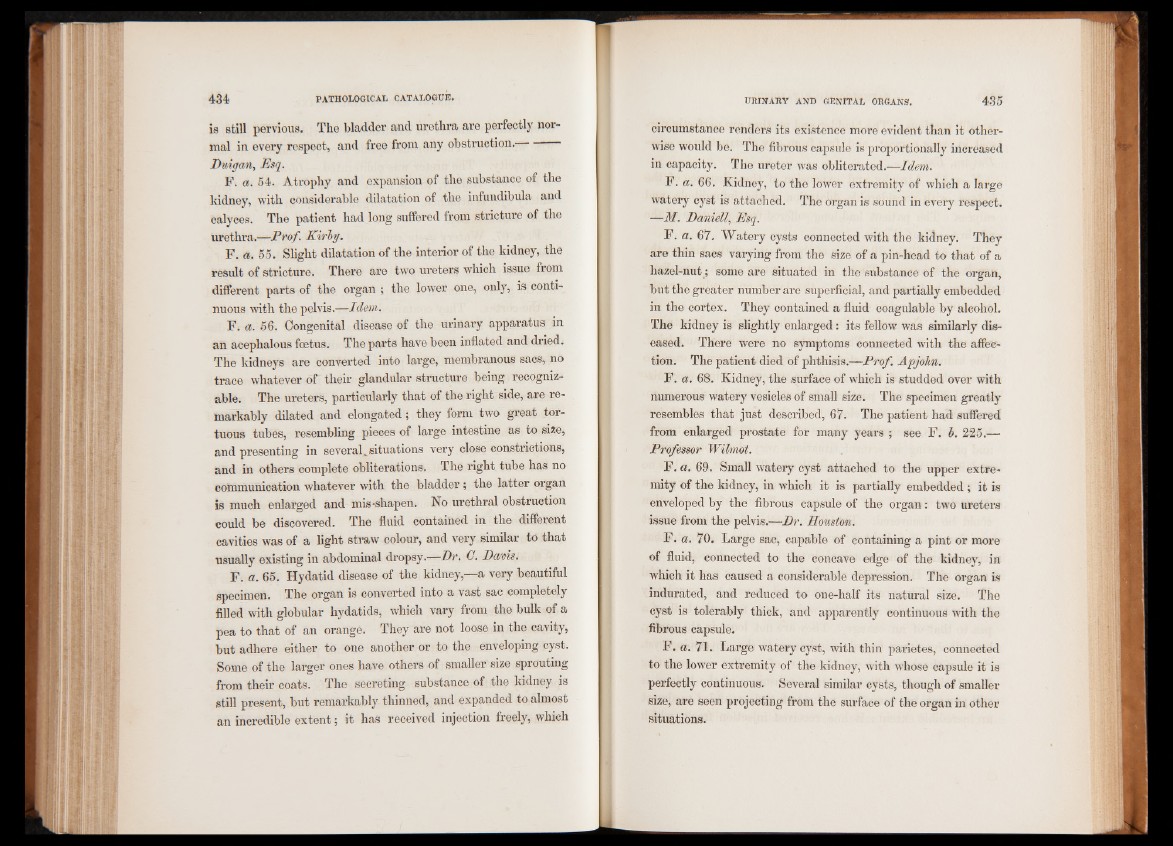
is still pervious. The bladder and urethra are perfectly normal
in every respect, and free from any obstruction.
Duigan, Esq.
F. a. 54. Atrophy and expansion of the substance of the
kidney, with considerable dilatation of the infundibula and
calyces. The patient had long suffered from stricture of the
urethra.—Prof. Kirby.
F. a. 55. Slight dilatation of the interior of the kidney, the
result of stricture. There are two ureters which issue from
different parts of the organ ; the lower one, only, is continuous
with the pelvis.—Idem.
F. a. 56. Congenital disease of the urinary apparatus in
an acephalous foetus. The parts have been inflated and dried.
The kidneys are converted into large, membranous sacs, no
trace whatever of their glandular structure being recognizable.
The ureters, particularly that of the right side, are remarkably
dilated and elongated; they form two great tortuous
tubes, resembling pieces of large intestine as to size,
and presenting in several^situations very close constrictions,
and in others complete obliterations. The right tube has no
communication whatever with the bladder; the latter organ
is much enlarged and mis-shapen. No urethral obstruction
could be discovered. The fluid contained in the different
cavities was of a light straw colour, and very similar to that
usually existing in abdominal dropsy.—Dr. O. Davis.
F. a. 65. Hydatid disease of the kidney,—a very beautiful
specimen. The organ is converted into a vast sac completely
filled with globular hydatids, which vary from the bulk of a
pea to that of an orange. They are not loose in the cavity,
but adhere either to one another or to the enveloping cyst.
Some of the larger ones have others of smaller size sprouting
from their coats. The secreting substance of the kidney is
still present, but remarkably thinned, and expanded to almost
an incredible extent; it has received injection freely, which
circumstance renders its existence more evident than it otherwise
would be. The fibrous capsule is proportionally increased
in capacity. The ureter was obliterated.—Idem.
F. a. 66. Kidney, to the lower extremity of which a large
watery cyst is attached. The organ is sound in every respect.
—M. Daniell, Esq.
F. a. 67, Watery cysts connected with the kidney. They
are thin sacs varying from the size of a pin-head to that of a
hazel-nut ; some are situated in the substance of the organ,
but the greater number are superficial, and partially embedded
in the cortex. They contained a fluid coagulable by alcohol.
The kidney is slightly enlarged: its fellow was similarly diseased.
There were no symptoms connected with the affection.
The patient died of phthisis.—Prof. Apjohn.
F. a. 68. Kidney, the surface of which is studded over with
numerous watery vesicles of small size. The specimen greatly
resembles that just described, 67. The patient had suffered
from enlarged prostate for many years ; see F. 1. 225.—
Professor Wilmot.
F. a. 69. Small watery cyst attached to the upper extremity
of the kidney, in which it is partially embedded | it is
enveloped by the fibrous capsule of the organ: two ureters
issue from the pelvis.—Dr. Houston.
F. a. 70. Large sac, capable of containing a pint or more
of fluid, connected to the concave edge of the kidney, in
which it has caused a considerable depression. The organ is
indurated, and reduced to one-half its natural size. The
cyst is tolerably thick, and apparently continuous with the
fibrous capsule.
F. a. 71. Large watery cyst, with thin parietes, connected
to the lower extremity of the kidney, with whose capsule it is
perfectly continuous. Several similar cysts, though of smaller
size, are seen projecting from the surface of the organ in other
situations.